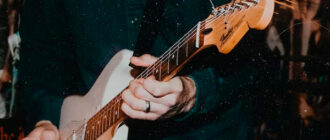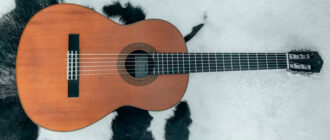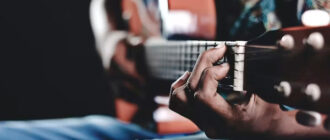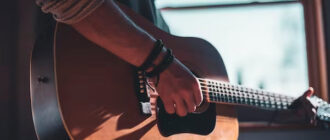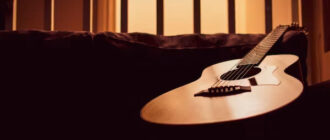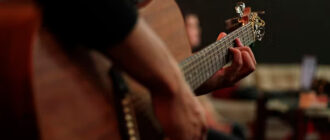
How to Paint Your Guitar: Transform Your Instrument with Ease! Tired of the same old look? Follow our step-by-step guide on how to paint your guitar at home, and give it a fresh, updated appearance. Discover essential tips, color choices, and techniques to unleash your creativity. Whether you’re a seasoned guitarist or a DIY enthusiast, this comprehensive walkthrough ensures a smooth and satisfying painting process.
Table of Contents
What Kind of Paint Do You Use on a Guitar?
Using the right type of paint is crucial in achieving a professional-looking paint job. Automotive spray paint or nitrocellulose lacquer are popular choices for painting guitars. These paints are durable and can handle the wear and tear that comes with playing your guitar. However, if you’re a beginner, you may want to start with a water-based wood paint specifically made for guitars. They’re easier to apply and dry faster than other types of paint. Don’t put your guitar back in the case after painting it, let it dry. You should also consider polishing, applying clear poly or a nitro finish.
Do I Need to Remove the Old Paint before Painting My Electric Guitar?
Yes, you need to remove the old paint before painting your electric guitar. Sanding is the easiest way to remove the old finish which is probably the original finish on the bare wood. There should not be many coats. Start with a coarse sandpaper grit and work your way up to finer grit sandpaper until you’ve removed all the existing finish and primer coat. If you’re painting an acoustic guitar, you may need to use a chemical paint stripper to remove the old finish.
Can I Just Paint Over My Guitar?
No, you can’t just paint over your guitar. The new paint won’t adhere properly to the surface of the guitar, and the finish will look uneven. Removing the old paint is necessary for a successful paint job.
Can I Use Acrylic Paint on My Guitar?
While you can use acrylic paint on your guitar, it’s not the best choice. Acrylic paint isn’t as durable as other types of paint and may not give you the finish you’re looking for.
How to Paint an Electric Guitar?
Now that we’ve covered the basics, let’s dive into the step-by-step process of painting your electric guitar. You can paint your electric guitar at home. Just be mindful of the guitar strings.
Gather Your Tools and Equipment

Image by https://firmbee.com/ from Unplash
Before you start painting your guitar, you’ll need to gather all the tools and equipment you’ll need. You’ll need sandpaper, grain filler, putty, primer, spray paint, clear coat, and mineral spirits. Make sure to get the right type of paint for your guitar, depending on the finish you’re going for.
Break Down the Guitar
To make painting your guitar easier, you’ll need to disassemble it. Remove the neck, bridge, pickup, and pickguard. This will allow you to paint the entire body of the guitar without any obstacles. Be sure that you are able to put the guitar back together, reassemble the guitar including the neck of the guitar and the bridge of the guitar. After painting, don’t touch your guitar for a while. A typical guitar might need some time to dry. If it is difficult to remove the parts of the guitar (especially, removing the strings), ask a professional for help to disassemble the entire guitar.
Remove the Old Finish
As we mentioned earlier, removing the old finish is crucial for a successful paint job. Use sandpaper to sand the body of the guitar in the direction of the grain until the old finish is completely removed. If there are any dents or scratches, use wood filler to fill them in. Use finish without damaging components on the neck joint.
How to Paint Your Guitar?
Once the guitar body is smooth and free of any old finish, it’s time to start painting. Start with a coat of primer to ensure that the paint adheres properly to the surface of the guitar. Let the primer dry completely before moving on to the color coat.
When applying the color coat, make sure to spray in thin coats and let each coat dry completely before applying the next one. You’ll need to apply multiple coats to get an even finish. Once you’ve achieved the color you’re looking for, let the paint dry completely before adding the clear coat.
The clear coat will protect the paint and give it a glossy finish. Apply several coats of clear coat, and let each coat dry completely before applying the next one.
Can You Brush Paint a Guitar?

Image by Jonathan Dubon from Unplash
While you can brush paint a guitar, it’s not recommended. Brush marks will be visible, and the finish won’t look as smooth as if you use spray paint. If this is a guitar to make you seem funny and relaxed, then go for it. Use water based wood paint specifically for guitars, and go for several coats of primer (minimum of 2). If you plan on using it on gigs, we recommend going to a professional. You need to wait, but a professional will solder the wires, apply high gloss and a second layer, so your guitar looks amazing.
Tips
– Don’t rush the process. Take your time and make sure each coat of paint is dry before moving on to the next one.
– Sand the body of your guitar between each coat of paint to ensure a smooth finish.
– When wet sanding, make sure to use a high grit sandpaper (1200 grit or higher) to avoid scratching the surface of the guitar.
– Make sure not to sand against the direction of the grain.
– Use a clear gloss top coat to give your guitar a mirror shine.
Warnings
– Make sure to remove the strings before painting your guitar.
– Removing the finish can be difficult and messy. Make sure to wear a mask and gloves to protect yourself.
– After sanding, make sure to wipe away the dust with a damp cloth.
Painting your guitar can be a fun and rewarding project. By following these steps and using the right type of paint, you can give your guitar a new and updated look. Just remember to take your time, don’t skip any steps, and have fun!

